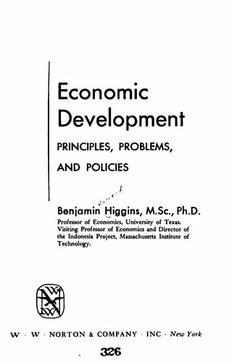Table Of ContentEconomic
Development
PRINCIPLES, PROBLEMS,
AND POLICIES
/.
^ «•
Benjamin Higgins, M.Sc., Ph.D.
Professor of Economics, University of Texas.
Visiting Professor of Economics and Director of
the Indonesia Project, Massachusetts Institute of
Technology.
W W N O R T O N & COM PANY IN C Nev) York
326
HP
1959
COPYRIGHT © BY \V. VV. NORTON & COMPANY, INC.
Library of Congress Catalog Card No. 59-6085
PRINTED IN THE UNITED STATES OF AMERICA
FOR THE PUBLISHERS BY THE VAIL-BALLOU PRESS
23456789
TO THOSE WHO TAUGHT ME MOST
Alvin Hansen
Herbert Heaton Lionel Robbins
A rthur Marget Paul Rosenstein-Rodan
Contents
Preface xiii
.______________________________ PART 1 _________________________________
Introduction: The Problem of Economic Development
1. The General Nature of the Development Problem 3 .
The Meaning of “Underdeveloped” Other Char
acteristics of Underdeveloped Countries The Con
cept of Economic Development Policy
2. Some Case Studies 25
Libya India Indonesia The Philippines Mexico
Italy Summary and Conclusions
PART 2
Principles: General Theories of Development
3. The Classical Theory of Capitalist Development:
G row th and Stagnation 85
The Classical Model The Malthus Version
4. The Marxist Model: Growth and Collapse 107
Propositions Summary The System in Operation
The Theory of Economic Fluctuations Conclusions:
An Appraisal
5. Unstable Growth: Schumpeter 122
Propositions Scope of the System Operation of the
System Schumpeter's Theory of Trend
via
Vlil CONTENTS
6. Cumulative Movement away from Equilibrium: Harrod 144
Outline of the Model Application to Underdeveloped
Areas
7. Requirements for Steady Growth: Hansen 167
The Essence of the Theory Aggravating Factors:
Capital-saving Innovations The “Great New Indus
tries” Argument Aggravating Factors: The Loss of
the uFrontier Spirit” A Rising Propensity to Save?
Logical Validity of the Hansen Thesis The Autono
mous Investment Function Resource Discovery and
the Frontier Application to Underdeveloped Areas
8. Summary and Synthesis of General Theories of De
velopment 199
Similarities and Differences Application to Underde
veloped Areas Population Growth Synthesis of
General Theories
_________________________________ PART 3 _________________________________
Principles: Lessons of History
9. Historical Theories of the Rise of Capitalism 217
The uRise of Capitalism” Commercial Capitalism
Financial Capitalism Industrial Capitalism and Urban
ism Entrepreneurship Capitalistic Agriculture
Rostov) and the Take-off into Sustained Growth
10. Economic Development: Past and Present 239
Economic Factors Political Factors Sociological
Factors Technological Factors An Impossible
Task?
_________________________________ PART 4 _________________________________
Principles: Theories of Underdevelopment
11. General Theories: Geographic Determinism 265
Human Behavior m the Tropics Reason for Low Pro
ductivity in Tropical Agriculture Conclusion
12. General Theories: Sociological Dualism 274<
The Theory Policy Implications Appraisal of the
Theory The Facts Is MDualism” an Eastern Phe
nomenon? Is Western Social Theory Applicable to
Underdeveloped Areas?
CONTENTS ix
\
13. Partial Theories: Culture Patterns, Achievement Mo
tivation, and Entrepreneurship
un-achicvement” and Entrepreneurship Hagen's "— '
Theory of Transition to Economic Growth
14. Partial Theories: Technological Dualism and the Popu
lation Explosion 314
The Population Explosion Hagen*5 “Common Sense
of Population” Population Pressure as a Stimulant to
Growth Technological Dualism Summary and
Conclusions
15. Partial Theories: Colonialism and the “Backwash” Ef
fects of International Trade
’V
Backwash versus Spread Effects Professor Myrdal
and the “Backwash Effect” Unlimited Supplies of
Labor? The Terms of Trade Terms of Trade of
the Country as a Whole The Thesis for Latin Amer
ica The Prebisch Argument Singer Version
Criticism of the Prebisch-Smger Thesis The Atallah
Analysis Terms of Trade of the Rural Sector
16. Partial Theories: Balanced Growth, Discontinuities, and
the “Big Push” 384
Rosenstein-Rodan and the Three Indivisibilities The
Leibenstem Theory The Low-level Equilibrium Trap
Balanced versus Unbalanced Growth
17. A Synthesis of Theories of Underdevelopment 409
Scope and Method A Diagrammatic Synthesis
/
PART 5
Policies
18. The Welfare Economics of Growth 432 ^
The Limits of Theory Growth through Laissez Faire?
Marginalism, the Economic Calculus, and the Phase of
Development
19. The Primrose Paths 457
Up by the Bootstraps? Finance by Inflation? Infla- ^
tion versus the “Disequilibrium Economy ” Pump-
priming Confiscation of Foreign Enterprises Con
clusions
X CONTENTS
✓20. Public Financc versus Financing Development 474
Public Finance Fiscal Policy
21. Measures to Increase Savings 480
Savings versus Credit Government Borrowing
^ 22. Tax Policies 493
The Question of Tax Capacity Taxation and Infla
tion Other Objectives of Tax Policy Local Gov
ernment Finance Incentive Taxes
✓ 23. A Self-enforcing Tax System for Underdeveloped
Countries 524
An Integrated Self-enforcing Tax System Incentive
Features A Tax-and-Transfer System for Foreign
Investors
24. Stabilization Policies 545
Fluctuations in Arid Zone Countries Fluctuations in
Exports Monetary Policy Anticyclical Timing of
Public Developmental Investment
25. Foreign Investment 569
Foreign Aid or Private Foreign Investment? Encour
agement of Private Foreign Investment Factors
Limiting Foreign Private Investment Major Conclu
sions
26. Foreign Aid 595
The International Monetary Fund and the International
Bank for Reconstruction and Development Bilateral
Capital Assistance The Over-all Picture The
Ai./.T. Proposal Loans or Grants? Should Foreign
Aid and Investment Equal the Foreign Exchange Com
ponent of Development?
\/27. Planning Economic Development 629
Measuring Economic Development Aspects of Devel
opment Planning Aspects of Planning and Phases of
Economic Development Estimating Capital Require
ments: The Incremental Capital-Output Ratio In
vestment Criteria and Priorities The Choice of Tech
nology Land-use Planning The Role of Commu
nity Development
28. Population Policy 687
CONTENTS xi
29. Some Lessons of Experience 701
Libya India Indonesia The Philippines Italy
30. Conclusions: Proposals for Research 766
Bibliography 775
Index 781

